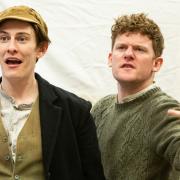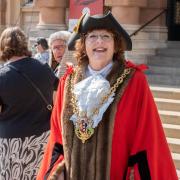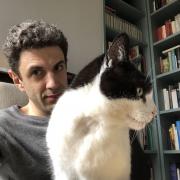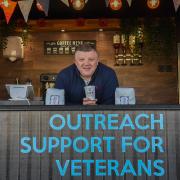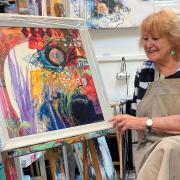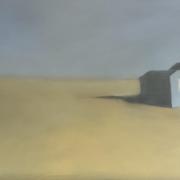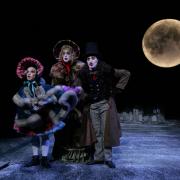When Havergate boy Charlie Brinkley lost his hand in a freak accident his hopes of a career at sea ended. But he became the Bawdsey-to-Felixstowe ferryman and his prosthetic metal hook inspired the scientists developing Britain’s war-winning radar technology

In an isolated, often wind-swept corner of Suffolk a pile of lichen spotted bricks lays almost invisible among the seagrass and gorse of the county’s only island. They are all that remains of Marsh House, the modest farmhouse on Havergate where on one cold winter’s day 125 years ago young Charlie Brinkley’s life changed forever.
Robert and Elizabeth Brinkley, Charlie’s parents, lived a simple life. Robert earned a meagre living as a fisherman, stockman and shepherd. Their eldest boy, Charles Robert Brinkley, who would become the first in a line of Felixstowe ferryman from the Brinkley family, was born on March 3 1871 at Langenhoe, Essex. But by the time Charlie was two years old Robert and Elizabeth Brinkley had returned to Suffolk to live in Quay Street in Orford.
Here Charlie grew up with his siblings, including his youngest brother William, until 1885 when Robert took work as a stockman on Havergate and the Brinkleys moved to an isolated cottage there.
Charlie, now of working age, made his way to Aldeburgh where he obtained work on the fishing fleet. When not fishing on the cod smacks Gypsy and Victor, he returned to his parents on the island, spending his shore leave helping his father and brother tend the herd, maintain ditches and keep the tide at bay.

Later, he worked aboard the Rope family’s schooner Rudolph, transporting coal and corn between Orford and the coastal ports. Before his teenage years were through, Charlie sailed further afield, this time on a barquentine plying between Harwich harbour and the West Indies. Shore leave would bring him back to Havergate, even though getting home was not easy.
“He used to walk from Harwich to Orford, across the river at Felixstowe Ferry and along the beach,” says Charlie’s grandson, Robert Brinkley. Robert remembers his own father telling him stories about his grandfather, including what happened when he returned with an unusual cargo.
“One time he brought two monkeys home with him from a trip abroad. He brought them back in a sack,” says Robert. While Charlie was at Bawdsey one of the monkeys escaped, making a dash for freedom up the cliff.
“No-one’s ever seen it since. But he had the other one on Havergate Island. It used to jump up and take potatoes off the stove and throw them at him. Once, it jumped up on his shoulder whilst he was washing and shaving and cut his ear with a cut throat razor.”

Read: This Suffolk vicar was one of the first people to discover gold in Australia
At Christmas 1890, Charlie spent a cold, bleak shore leave with on Havergate his parents and younger brother William, now 17 years old. He helped his father and William with the daily tasks, but one fateful day decided upon a spot of wildfowling.

In the small kitchen of Marsh House Charlie prepared the gun he would use – but he would not go out shooting that day. There was a terrible accident inside the farmhouse, although accounts do vary.
“Someone said it was a muzzle-loader that blew up, but my father always said that he [Charlie] had a silent poacher’s gun that used compressed air,” says Robert. “It was filled by pumping it with a bicycle pump. Charlie put the pump in to pump it up but it was already pumped up. It fired and smashed his hand against a low beam in the kitchen.”
Charlie suffered an agonising injury and needed immediate medical treatment. His mother made a temporary dressing and Robert took him by rowing boat to Orford quay where he found someone willing to take them to Ipswich on a pony and trap. It was a slow, harrowing journey for the teenager.
Doctors fought to save Charlie’s hand, but the damage was too severe. His right hand was amputated above the wrist. Months of recuperation and rehabilitation followed, but Charlie’s seagoing days were over. Little is known about the next five years of Charlie’s life. He was fitted with a prosthetic hook to replace his right hand and obtained work as a ferryman on the Bawdsey ferry.

Sir Cuthbert Quilter, owner of Bawdsey Manor, was an MP and businessman who travelled regularly between Suffolk and London. In August 1894 he started a private ferry service across the mouth of the Deben. His chain ferries, Lady Quilter and Lady Beatrice, significantly shortened what was otherwise a journey of 23 miles around the estuary between Bawdsey and Felixstowe. Quilter appointed Charles Brinkley ferryman in 1895, and it was not long before he had written himself into local folklore.
One day in a winter chill a horse-drawn cart boarded Charlie’s ferry at Bawdsey. The horse bolted, throwing itself, the cart and 11-year-old John Sawyer from Hollesley into the freezing waters of the Deben. The tide was racing, but with no fear for his own safety Charlie jumped into the river and rescued young John. Though the boy’s life was saved, the horse drowned.
On August 26 1896, Charles Brinkley was awarded the Royal Humane Society’s Bronze Medal for putting his own life at risk to save someone else. Robert still has the medal and knows the story does not end there. Sawyer came back to Bawdsey and met Charlie several times after the First World War.
In 1952 Sawyer’s daughter-in-law, Eva Sawyer, met Charlie at Felixstowe Ferry, describing him later as “a wonderful man”.
The description fitted Charlie well. He was respected and loved by family, customers and villagers. For over 40 years he navigated, first Quilter’s ferries and then his own service across the ever changing waters of the Deben. His knowledge of the shifting sands and fearsome tides were legendary, as was his ability to row and skipper his little boat with just one hand. He called a spade a spade and, so typical of those Suffolk men grinding out a hard living on sea or land, did not suffer fools. He was never defeated by his handicap, and his hook became a part of him.
“It was amazing how he carried on regardless,” says granddaughter Ann White. “Fantastic. He could even do his own shoe laces up, and could tie a bowline knot. An amazing man.”
Though Charlie’s son (also Charlie) took over the ferry just before the outbreak of the Second World War, Charlie senior continued to cross the Deben from his home in Bawdsey to the hamlet at Felixstowe Ferry. Through the 1940s he ferried personnel back and forth from RAF Bawdsey in his own boat, especially late at night when the RAF’s offical ferry had finished for the day. He remained a popular figure on both sides of the water living at No 2 Quay Cottages Bawdsey until his death in 1963. He is remembered fondly.
“He was really kind,” says granddaughter Lilian Miles. “I never saw him angry and my friends always liked going to see him. He always used to have a big jar of humbugs in his napsack. He use to feed us those, whether we were supposed to eat them or not. Mum wasn’t very impressed!”
But it was Charlie’s time on the ferry in the 1930s that guaranteed his name would be known much further afield than the hamlet he had made his home.
In 1936 the Quilters sold Bawdsey Manor to the Ministry of Defence and RAF Bawdsey become synonymous with the development of radio direction finding technology. Scottish pioneer Robert Watson-Watt and his team of scientists moved to RAF Bawdsey and often took Charlie’s ferry across the river. Watson-Watt came to know the Charlie Brinkley well.
David Heath, trustee of the Bawdsey Radar Trust that runs Bawdsey Transmitter Block Museum, says that radar, as the technology came to be known, requires high voltage electricity to generate its beam of radio waves.
“An ‘earthing hook’ had long been used as a safety device once current through high voltage power cables had been switched off. An insulated hook connected to earth was hooked over them to ensure any voltage was discharged before the cables or any connected equipment were touched.”
The end of the device resembled Charlie Brinkley’s hook. “The device became known as a Brinkley Hook once Watson-Watt came to know Charlie Brinkley,” says David.
It is a fitting tribute to Charlie, a reflection of the regard in which he was held by Watson-Watt and his team, and also a reminder of just how important the little ferry boat is in the history of RAF Bawdsey.
Today, in a quiet corner of Bawdsey churchyard Charles Robert Brinkley rests peacefully. Now, like his former home on Havergate, his grave is hardly noticeable. But for those who love this part of Suffolk and are absorbed in its history, or for those living in the hamlets at the mouth of the river, Charlie Brinkley remains as much a part of Felixstowe Ferry and of Bawdsey Quay as the ebbing and flowing of the Deben tide.




